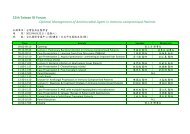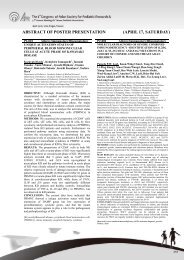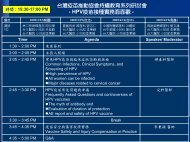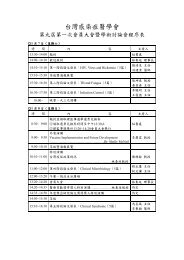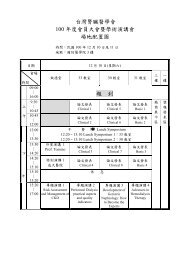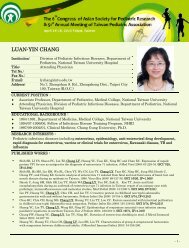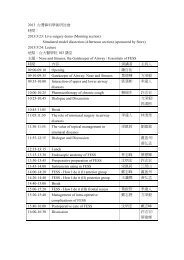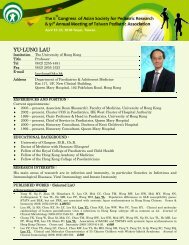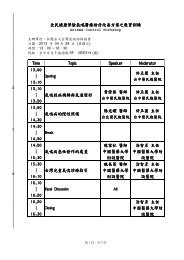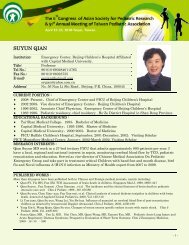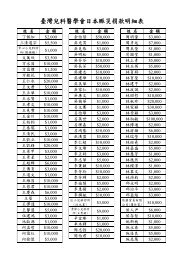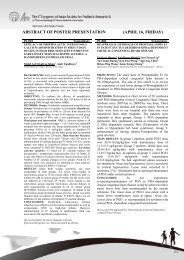ABSTRACT OF INVITED LECTURES AND ORAL PRESENTATION
ABSTRACT OF INVITED LECTURES AND ORAL PRESENTATION
ABSTRACT OF INVITED LECTURES AND ORAL PRESENTATION
- No tags were found...
Create successful ePaper yourself
Turn your PDF publications into a flip-book with our unique Google optimized e-Paper software.
MS3-02TRANSCATHETER CLOSURE <strong>OF</strong> VSD:CHINESE EXPERIENCEZhiwei ZHANGGuangdong Cardiovascular Institute, ChinaMS3-03STENTING <strong>OF</strong> DUCTUS ARTERIOSUS ASALTERNATIVE TO SURGICALSYSTEMIC-PULMONARY SHUNT INDUCT-DEPENDENT CYANOTIC CONGENITALHEART DISEASEMazeni AlwiInstitute Jantung Negara, MalaysiaSurgical repair of ventricular septal defects (VSD)has been clinically performed for decades andconsidered as the gold standard therapy up to date.However, it is associated with morbidity andmortality. Catheter intervention for VSD withdifferent-shaped double-disc occluders based onself-expandable materials (Amplatzer TM , Heartr TM ,Cera TM , etc.) has been clinically used for years andconsidered as alternative in selected patients.Transcatheter closure for muscular VSD (mVSD) hasshown advantages to surgical repair. As forperimenbranous VSD (pmVSD), clinical outcome,with advantages as well as disadvantages, are underintensive evaluation. From 1999 to 2007, 509 VSDpatients received transcatheter closure withAmplatzer TM (asymmetric) or Heartr TM (asymmetric,symmetric, larger-left-disc) occluders in GuangdongCardiovascular Institute. Here we shared ourtechnical experiences in catheter manipulation anddevice selection, as well as intermediate- tolong-term follow-up results. We reached conclusionsas listed below:1. Transcatheter closure of pmVSD is safe andeffective.2. Both asymmetric and symmetric occluders areequally effective for VSD closure.3. Both asymmetric and symmetric occluders havesimilar risk of major complications includinghemolysis, complete atrio-ventricular block,severe aortic or tricuspid regurgitation.4. Asymmetric occluders have increased risk ofminor complications, such as mild arrhythmiasand instant residual shunt.5. Device selection must be individualized.For many decades, systemic to pulmonary shunt (BlalockTaussig Shunt) is a widely performed palliative cardiac surgeryfor cyanotic heart disease. It allows relatively normal growthbefore corrective surgery can be performed at a later age.Advances in paediatric cardiac surgery and post operative carehas allowed complex cyanotic cardiac lesions to be repairedearly in infancy, obviating the need for palliative surgery.However a number of lesions with duct dependent pulmonarycirculation can still be corrected only at a later age and BlalockTaussig shunt remains an important part of the management.In the modern era, Blalock Taussig shunt is almost exclusivelyperformed in the neonatal period. This accounts for thesignificant morbidity of this procedure such as early shuntthrombosis and those related to thoracotomy such asdiaphragmatic paralysis and chylothorax.With advances in percutaneous coronary interventions, applyingcoronary stents to maintain PDA patency is less invasive andattractive alternative to Blalock Taussig shunt. Earlier attemptsto maintain ductal patency by formalin infiltration and use ofheated balloons have not been successful. Result of PDAstenting has been encouraging. However, there are a number ofpertinent issues. Unlike the PDA as an isolated lesion, theductus in cyanotic heart disease have a remarkable morphologicvariability. The ductus tends to arise more proximally underthe aortic arch, giving rise to a vertical PDA or occasionally itmay arise from the subclavian artery. It also tends to be longand sometimes very tortuous, rendering stent implantationtechnically impossible. The ductus in these patients may alsoinsert onto one of the branch pulmonary arteries with somestenosis at the site of insertion (“pulmonary coarctation”).Stenting the PDA in this situation accelerates and exaggeratesthis pulmonary coarctation.With regards to clinical research, issues of concern areperforming a procedure which has relatively high risk against astandard surgical procedure albeit with known seriouscomplications. The variation in ductal morphology also raisesconcerns regarding patient selection and contra-indication to theprocedure.As a new procedure, documentation and close follow up areimportant in order that safety and efficacy data can beestablished to be measured against standard surgical procedure,and to see wether it merits a place in the routine management ofcomplex cyanotic congenital heart disease.59



